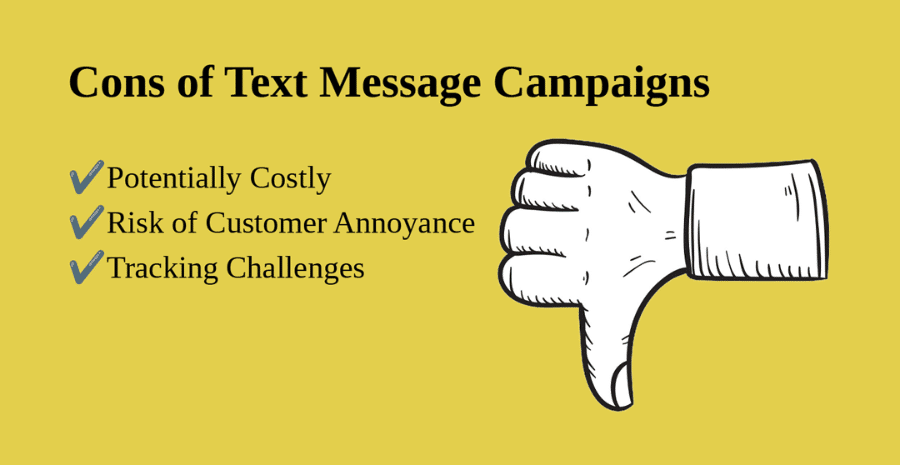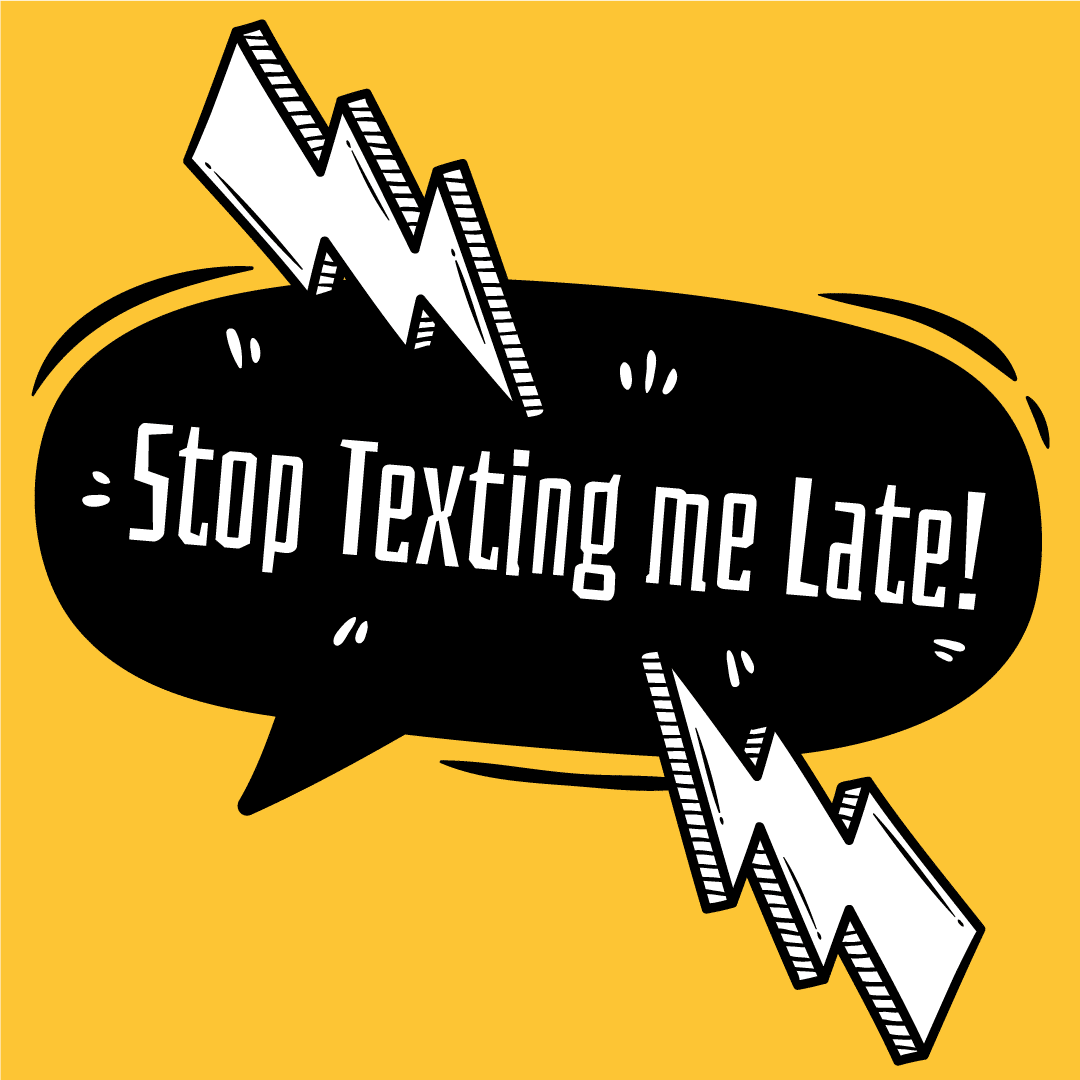Table of Contents
In digital marketing, SMS campaigns have emerged as a powerful tool for reaching customers directly. However, like any marketing strategy, they come with their own set of challenges. While SMS can be highly effective, it’s essential to be aware of the potential drawbacks that could impact your campaign’s success. In this article, we’ll explore the cons of SMS campaigns, shedding light on the costs, risks, and complexities involved so you can make informed decisions for your business.

Main Ones
Potentially Costly: Implementing SMS campaigns can require significant investment, particularly for large-scale operations. Costs can include not only the messaging itself but also the integration of SMS with existing systems, compliance with regulations, and the use of specialized software to manage and analyze campaigns. These expenses can add up, especially as your customer base grows.
Risk of Customer Annoyance: Frequent or poorly timed messages can irritate customers, leading to negative perceptions of your brand. If your messaging isn’t carefully planned and relevant, customers may perceive it as intrusive, resulting in higher opt-out rates and even damaging your brand’s reputation. To avoid this, it’s crucial to ensure that messages are timely and personalized and add value to the customer experience.
Tracking Challenges: Monitoring and analyzing data from SMS campaigns can be complex, making it harder to measure effectiveness accurately. Unlike other digital channels, SMS lacks the extensive analytics tools available for email or social media marketing. This can make it challenging to track open rates, engagement, and ROI, potentially leading to less informed decision-making.
Additional Concerns: Other issues might include regulatory compliance, such as adhering to laws like the TCPA (Telephone Consumer Protection Act), which governs how and when you can contact customers via SMS. The limited character count of SMS messages also requires concise, impactful communication, which can be a challenge when conveying complex information. Additionally, the requirement for customers to opt-in to receive SMS messages can restrict your audience size, potentially limiting the reach of your campaigns.
Some Additional Cons
Limited Engagement Opportunities: Unlike other digital marketing channels, SMS offers limited opportunities for rich media engagement. While SMS is great for quick, concise messages, it doesn’t allow for the interactive and visually engaging content that can be delivered through email, social media, or web platforms. This limitation can make it harder to fully capture your audience’s attention and interest.
Message Delivery Issues: Although SMS generally has a high delivery rate, there can still be issues with messages not reaching the intended recipients. Factors such as carrier restrictions, number blocking, or technical glitches can lead to undelivered messages, reducing the overall effectiveness of your campaign.
High Opt-Out Rates: SMS campaigns often have higher opt-out rates compared to other marketing channels. Because of the personal nature of text messaging, recipients may quickly unsubscribe if they feel the messages are irrelevant or too frequent. This can limit your ability to maintain a long-term communication channel with your audience.
Difficulty in Building a Subscriber List: Unlike email lists, building an SMS subscriber list can be more challenging due to stricter opt-in requirements. Consumers are often more hesitant to share their phone numbers compared to their email addresses, which can slow down the growth of your list and limit your campaign’s reach.
Potential Privacy Concerns: Handling and storing phone numbers and other personal data come with significant privacy responsibilities. Any breach or misuse of this data can lead to serious legal and reputational consequences, making it essential to implement stringent data protection measures.

Alternatives to SMS Campaigns
Other Marketing Channels
Email Marketing
- Overview: Email marketing allows for longer messages, detailed content, and rich media. It’s ideal for delivering newsletters, promotions, and personalized offers.
- Advantages: Unlike SMS, emails can include images, links, and more comprehensive information. They also provide better analytics and tracking options.
Push Notifications
- Overview: Push notifications are short messages that pop up on a user’s mobile device or desktop. They’re effective for time-sensitive offers and updates.
- Advantages: Push notifications can include rich media and are less intrusive than SMS, as they don’t require a phone number and can be easily managed by the user.
Social Media
- Overview: Social media platforms like Facebook, Instagram, and Twitter are excellent for engaging with your audience through posts, stories, and ads.
- Advantages: Social media allows for interaction, sharing, and targeting specific demographics. It’s also highly visual and can reach a broad audience.
Mobile Apps
- Overview: Mobile apps provide a direct channel to engage users through in-app messaging, push notifications, and personalized experiences.
- Advantages: Apps allow for highly targeted and personalized content, fostering customer loyalty and frequent engagement.
Integrated Marketing Strategies
- Omnichannel Approach: Combining SMS with other channels like email and social media creates a more robust marketing strategy. For example, you could use SMS for urgent alerts, email for detailed follow-ups, and social media for broader engagement.
- Cohesive Messaging: Ensure that your messaging across all channels is consistent, reinforcing your brand and message. This approach enhances the customer experience by providing multiple touchpoints that cater to different preferences.
By considering these alternatives and integrating them into your marketing strategy, you can overcome the limitations of SMS campaigns and reach your audience more effectively.

How to Mitigate the Drawbacks of SMS Campaigns
Best Practices
- Craft Concise Messages: Focus on delivering clear, direct messages that quickly convey the essential information. Use simple language and a strong call-to-action (CTA) to maximize impact within the 160-character limit.
- Audience Segmentation: Segment your audience based on demographics, behaviors, or preferences to send more targeted and relevant messages. Tailoring content increases engagement and reduces the likelihood of opt-outs.
- Respect User Preferences: Allow customers to choose the frequency and type of messages they receive. Providing options helps maintain customer satisfaction and lowers the risk of being seen as intrusive.
Compliance Tips
- Obtain Clear Consent: Always get explicit opt-in consent before sending SMS messages. Make sure the opt-in process is transparent, detailing what subscribers can expect.
- Include Opt-Out Options: Every message should include an easy opt-out method, such as replying “STOP.” This not only complies with regulations but also builds trust with your audience.
- Stay Updated on Regulations: Regularly review laws like TCPA and GDPR to ensure your campaigns remain compliant. Non-compliance can lead to hefty fines and damage your brand reputation.
Customer-Centric Approach
- Prioritize Value: Send messages that offer real value to your customers, such as exclusive deals, important updates, or personalized content. Avoid spamming to keep subscribers engaged and satisfied.
- Feedback Loops: Encourage feedback from your subscribers to understand their preferences better. Use this information to refine your approach and enhance the customer experience.
By following these strategies, you can effectively mitigate the drawbacks of SMS campaigns, ensuring they remain a valuable part of your marketing strategy while maintaining customer satisfaction and compliance.

Wrap-up!
While SMS campaigns offer undeniable benefits in terms of direct and immediate communication, it’s crucial to weigh these advantages against the potential drawbacks. Understanding the cons—such as cost, the risk of annoying customers, tracking difficulties, and compliance challenges—will help you better navigate the landscape of SMS marketing. By being mindful of these factors, you can craft more effective campaigns that not only reach your audience but also resonate with them in a positive way. Ultimately, the key is to balance the power of SMS with strategic planning and thoughtful execution.






